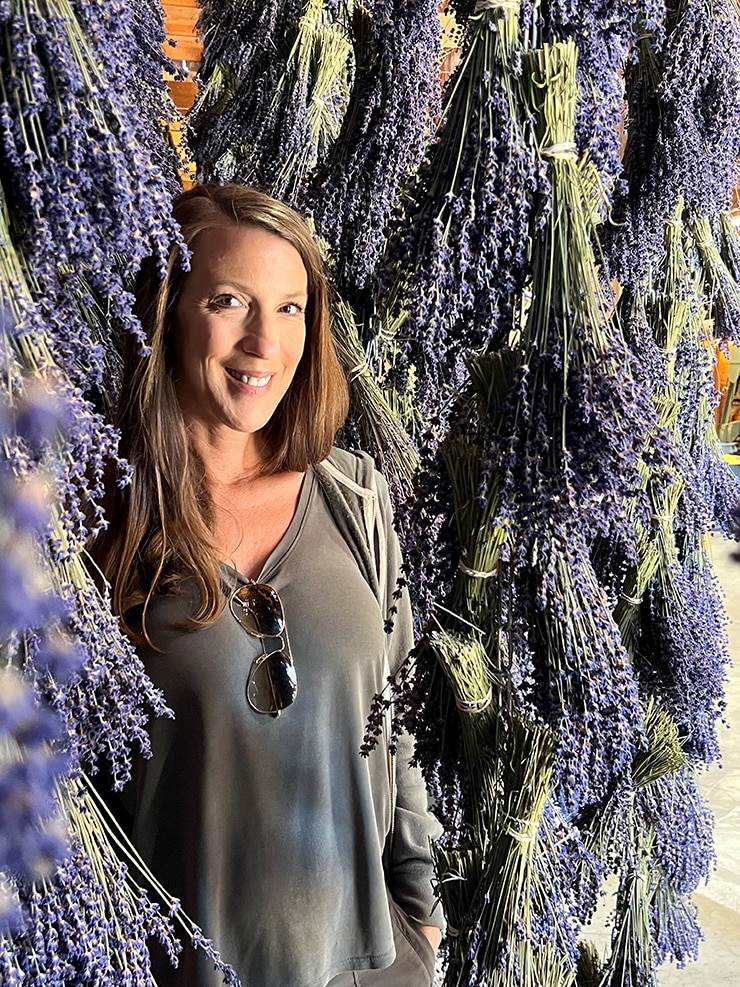
Every year my family travels to Sequim, Washington to the Lavender Festival. This year we visited B & B Family Lavender Farm (that’s a picture of me in their drying house). I use lavender essential oil regularly to sleep, add it to my lotion and love it in culinary dishes. While at B & B Family Lavender Farm I picked up a jar of Pear Lavender Jam and this pairs well with goat cheese and pork.
One easy tip that B & B shared to remember the different uses of lavender is this:
- English lavender is for eating
- French lavender is for fragrance
- Spanish lavender is for seeing
Lavender (Lavandula spp.) is a well-known and beloved aromatic herb that has been used for centuries for its pleasing fragrance and therapeutic properties. Native to the Mediterranean region, lavender is widely cultivated for its essential oils, culinary applications, and medicinal benefits. This article aims to delve into the nutritional content and explore the various health benefits associated with lavender. Additionally, we will highlight different ways to use lavender to enhance overall health.
Nutritional Content of Lavender
Lavender contains an array of bioactive compounds that contribute to its health-promoting properties. The nutritional content of lavender can vary depending on the species and growing conditions, but it generally includes the following components:
1. Essential Oils
The most notable constituents of lavender are its essential oils. Lavender essential oil is rich in volatile compounds, including linalool, linalyl acetate, camphor, and 1,8-cineole (Bakkali et al., 2008). These aromatic compounds are responsible for lavender’s characteristic scent and are believed to contribute to its therapeutic effects.
2. Polyphenols
Lavender is a source of polyphenolic compounds, such as flavonoids and tannins, which possess antioxidant properties. These compounds help neutralize harmful free radicals in the body and protect cells from oxidative damage (Russo et al., 2014).
3. Vitamins and Minerals
While lavender is not a significant source of vitamins and minerals, it does contain trace amounts of certain nutrients, including vitamin A, vitamin C, calcium, and iron (Asadi-Samani et al., 2015).
Health Benefits of Lavender
1. Relaxation and Stress Reduction
One of the most well-known benefits of lavender is its calming and relaxing properties. Research has shown that inhaling lavender essential oil can reduce stress and anxiety levels, promote relaxation, and improve sleep quality (Koulivand et al., 2013). Aromatherapy with lavender has been used in clinical settings to alleviate anxiety symptoms and support mental well-being.
2. Pain Relief
Lavender’s analgesic properties make it a potential natural remedy for pain relief. Topical application of lavender essential oil has been found to be effective in reducing pain and discomfort associated with conditions such as headaches, migraines, and menstrual cramps (Hosseini et al., 2016).
3. Anti-Inflammatory Effects
The bioactive compounds in lavender, particularly linalool and linalyl acetate, exhibit anti-inflammatory properties. These compounds may help reduce inflammation and provide relief from inflammatory conditions, such as arthritis (Agnihotri and Sontakke, 2014).
4. Antimicrobial Activity
Lavender essential oil possesses potent antimicrobial properties, making it effective against various bacteria and fungi. Studies have demonstrated its efficacy in inhibiting the growth of pathogenic microorganisms and potential use in wound healing (Carson et al., 2006).
5. Skin Health
Lavender’s soothing and antimicrobial properties also extend to skin health. It can be used to alleviate skin irritations, insect bites, and minor burns. Additionally, lavender oil may help promote wound healing and reduce the appearance of scars (Orchard et al., 2017).
Different Ways to Use Lavender
1. Aromatherapy
Inhaling the calming aroma of lavender essential oil through diffusers, room sprays, or inhalation sticks can help reduce stress, anxiety, and promote relaxation. French Lavender is used for fragrance and aromatherapy.
2. Lavender Tea
Dried lavender flowers can be steeped in hot water to create a soothing and aromatic herbal tea. Lavender tea is known for its relaxing properties and can be enjoyed before bedtime to aid sleep. Remember to use English Lavender for this.
3. Culinary Use
Lavender flowers can be added to culinary dishes to impart a delicate floral flavor. It is commonly used in desserts, baked goods, and as a garnish for various dishes. Remember to use English Lavender for this.
4. Lavender Oil Massage
Diluted lavender essential oil can be used for a calming and therapeutic massage to alleviate muscle tension and promote relaxation.
5. Lavender Bath
Adding a few drops of lavender essential oil to a warm bath can create a relaxing and aromatic soak, perfect for unwinding after a long day. I love Epsom salt baths with a few drops of lavender essential oil.
6. Lavender Pillow Sachets
Dried lavender flowers can be sewn into small fabric pouches and placed in pillowcases or drawers to enjoy their soothing fragrance.
Lavender is a delightful herb that not only fills the air with a beautiful aroma but also offers an array of health benefits. Rich in essential oils, polyphenols, and antioxidants, lavender has been traditionally used for its calming, pain-relieving, and anti-inflammatory properties. Incorporating lavender into daily life through aromatherapy, culinary use, or topical application can be a natural and effective way to promote relaxation, improve mood, and support overall well-being. As with any herbal remedy, it is essential to consult with a healthcare professional, particularly for individuals with allergies or sensitivities, before using lavender for medicinal purposes.
- Bakkali, F., Averbeck, S., Averbeck, D., & Idaomar, M. (2008). Biological effects of essential oils – a review. Food and Chemical Toxicology, 46(2), 446-475.
- Koulivand, P. H., Khaleghi Ghadiri, M., & Gorji, A. (2013). Lavender and the nervous system. Evidence-Based Complementary and Alternative Medicine, 2013, 681304.
- Russo, A., Formisano, C., Rigano, D., Cardile, V., & Arnold, N. A. (2014). Chemical composition and antimicrobial and antioxidant activity of essential oils of Lavandula X allardii and Lavandula angustifolia. Cell Biochemistry and Biophysics, 68(3), 449-454.
- Asadi-Samani, M., Moradi, M. T., Bahmani, M., & Shahrani, M. (2015). Medicinal plants with hepatoprotective activity in Iranian folk medicine. Asian Pacific Journal of Tropical Biomedicine, 5(2), 146-157.
- Hosseini, M., Ghafari, M. S., Rahimzadeh, P., & Ardekani, M. R. S. (2016). Effect of lavender oil massage on newborns’ pain and stool frequency in NICU. Iranian Journal of Neonatology, 7(3), 31-36.
- Agnihotri, S., & Sontakke, S. (2014). Antioxidant and adaptogenic activity of Lavandula angustifolia. Journal of Herbal Medicine and Toxicology, 8(2), 153-159.
- Carson, C. F., Hammer, K. A., & Riley, T. V. (2006). Melaleuca alternifolia (tea tree) oil: A review of antimicrobial and other medicinal properties. Clinical Microbiology Reviews, 19(1), 50-62.
- Orchard, A., van Vuuren, S., & Viljoen, A. (2017). The in vitro antimicrobial evaluation of commercially essential oils and their combinations
Enjoying this content? Sign up for updates... It's FREE!


